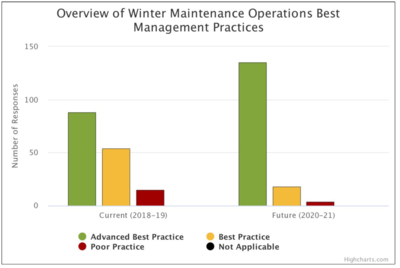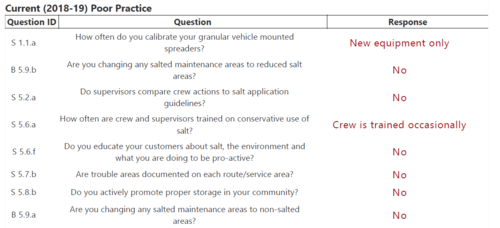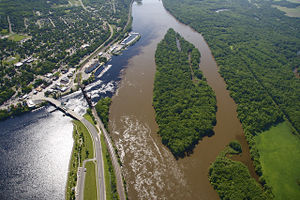
Difference between revisions of "Guidance for meeting chloride TMDL MS4 permit requirements"
m |
m |
||
| Line 6: | Line 6: | ||
[[File:MN Metro chloride impairments map.jpg|300px|thumb|right| alt=screenshot of metro chloride impairments|<font size=3>Map of chloride impairments in the metro area. For more details on the map click [https://mpca.maps.arcgis.com/apps/OnePane/basicviewer/index.html?appid=beed825528cf4a6a95256291ae903e2c here]</font size>.]] | [[File:MN Metro chloride impairments map.jpg|300px|thumb|right| alt=screenshot of metro chloride impairments|<font size=3>Map of chloride impairments in the metro area. For more details on the map click [https://mpca.maps.arcgis.com/apps/OnePane/basicviewer/index.html?appid=beed825528cf4a6a95256291ae903e2c here]</font size>.]] | ||
| + | |||
| + | This page provides guidance for <span title="A municipal separate storm sewer system (MS4) is a means of transportation, individually or in a system, (e.g. roads with drainage systems, municipal streets, catch basins, curbs, gutters, ditches, man-made channels, storm drains, etc.) that are: owned or operated by a public entity (e.g. cities, townships, counties, military bases, hospitals, prison complexes, highway departments, universities, etc.) with jurisdiction over disposal of sewage, industrial wastes, stormwater, or other wastes. This includes special districts under State law (sewer, flood control, or drainage districts, etc.), an authorized Indian tribal organization, or a designated and approved management agency under section 208 of the Clean Water Act; designed or used for collecting or transporting stormwater; not a combined sewer; and not part of a publicly owned treatment works."> '''MS4'''</span> (Municipal Separate Storm Sewer System) permittees who have permit requirements for chloride <span title="the amount of a pollutant from both point and nonpoint sources that a waterbody can receive and still meet water quality standards"> [https://stormwater.pca.state.mn.us/index.php?title=Total_Maximum_Daily_Loads_(TMDLs) '''total maximum daily load''']</span> <span title="the portion of a receiving water's assimilative capacity that is allocated to one of its existing or future point sources of pollution"> '''wasteload allocations'''</span>. | ||
==Total Maximum Daily Loads (TMDLs)== | ==Total Maximum Daily Loads (TMDLs)== | ||
| Line 19: | Line 21: | ||
##regular calibration of equipment; | ##regular calibration of equipment; | ||
##optimizing mechanical removal to reduce use of deicers; and/or | ##optimizing mechanical removal to reduce use of deicers; and/or | ||
| − | ##designation of no salt and/or low salt zones | + | ##designation of no salt and/or low salt zones [Minn. R. 7090] (Permit item 22.6). |
==Document the amount of deicer applied== | ==Document the amount of deicer applied== | ||
'''Permit item 22.5 - Document the amount of deicer applied each winter maintenance season to all permittee owned/operated surfaces.''' | '''Permit item 22.5 - Document the amount of deicer applied each winter maintenance season to all permittee owned/operated surfaces.''' | ||
| − | + | Permittees are required to track the amount of deicer applied. For each application event, permittees should also consider tracking the following. | |
*material used (e.g. sodium chloride, calcium chloride, etc.) | *material used (e.g. sodium chloride, calcium chloride, etc.) | ||
*location where material was applied | *location where material was applied | ||
Revision as of 21:09, 9 May 2020
This page is under review during the MS4 Phase 2 permit reissuance period
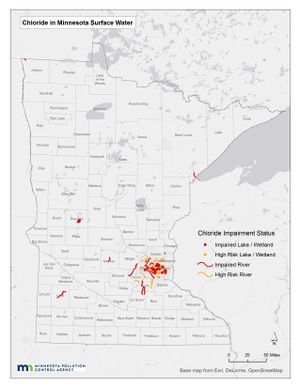
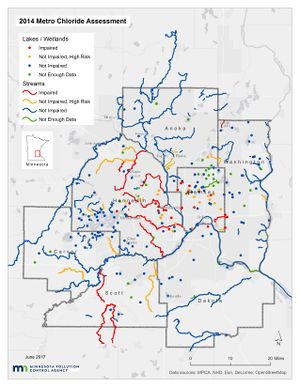
This page provides guidance for MS4 (Municipal Separate Storm Sewer System) permittees who have permit requirements for chloride total maximum daily load wasteload allocations.
Contents
- 1 Total Maximum Daily Loads (TMDLs)
- 2 Document the amount of deicer applied
- 3 Annually conduct an assessment of the permittee’s winter maintenance operations
- 4 TMDL MS4 permit guidance
- 5 TMDL toolkit for MS4 permit compliance
- 6 TMDL guidance and general information
- 7 Information received from MS4 permittees
- 8 Links and other resources
Total Maximum Daily Loads (TMDLs)
There are currently 40 lakes and streams in the Twin Cities Metro Area that are impaired by chloride. There are an additional 10 lakes and streams that are impaired by chloride in greater Minnesota. See the MPCA’s chloride webpage for more information on the sources of chloride, environmental impacts, and opportunities for your community to reduce salt.
The EPA has approved 40 total maximum daily loads (TMDLs) that include MS4 (Municipal Separate Storm Sewer System) wasteload allocation (WLAs) for chloride. Click here to link to MPCA's impaired waters website. A map illustrating U.S. EPA-approved listings for chloride is shown on the right. The TMDLs were developed as part of the Twin Cities Area Metro Chloride TMDL, Ninemile Creek TMDL, and the Shingle Creek TMDL. See the statewide chloride resources page for more information.
The MS4 permit contains the following requirements for permittees that have an applicable wasteload allocation (WLA) for chloride.
- Document the amount of deicer applied each winter maintenance season to all permittee owned/operated surfaces (Permit item 22.5).
- Each calendar year, conduct an assessment of the permittee’s winter maintenance operations to reduce the amount of deicing salt applied to permittee owned/operated surfaces and determine current and future opportunities to improve best management practices (BMPs). The permittee may use the Agency’s Smart Salting Assessment Tool or other available resources and methods to complete this assessment. The permittee must document the assessment. The assessment may include, but is not limited to:
- operational changes such as pre-wetting, pre-treating the salt stockpile, increasing plowing prior to deicing, monitoring of road surface temperature, etc.;
- implementation of new or modified equipment providing pre-wetting, or other capability for minimizing salt use;
- regular calibration of equipment;
- optimizing mechanical removal to reduce use of deicers; and/or
- designation of no salt and/or low salt zones [Minn. R. 7090] (Permit item 22.6).
Document the amount of deicer applied
Permit item 22.5 - Document the amount of deicer applied each winter maintenance season to all permittee owned/operated surfaces.
Permittees are required to track the amount of deicer applied. For each application event, permittees should also consider tracking the following.
- material used (e.g. sodium chloride, calcium chloride, etc.)
- location where material was applied
- date
- air temperature
- pavement temperature
- relative humidity (RH)
- dew point
- cloud cover
- operator
- event start
- event end
- event type (e.g. snow, rain, both)
- total precipitation, and
- application rate.
The Minnesota Snow and Ice Control Field Handbook for Snowplow Operators includes examples of salt tracking forms that could be used (see Appendix). The Winter Parking Lot and Sidewalk Manual also includes tracking forms for anti-icing and de-icing (see below).
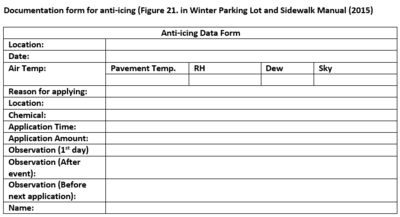
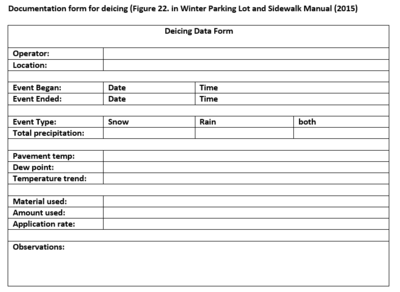
Annually conduct an assessment of the permittee’s winter maintenance operations
Permit item 22.6 - Annually conduct an assessment of the permittee’s winter maintenance operations to reduce the amount of deicing salt applied to permittee owned/operated surfaces and determine current and future opportunities to improve BMPs.
Permitted MS4s with an applicable WLA for chloride are required to assess winter maintenance operations annually and identify current and future opportunities to improve practices to reduce the amount of de-icer used. The permittee may use the Smart Salting Assessment Tool (SSAt) or other available resources and methods to complete this assessment.
The SSAt has been developed as a resources of all known current salt saving BMPs. The SSAt is a free, web‐based tool that can be used to assist public and private winter maintenance organizations in determining where opportunities exist to improve practices, make reductions in salt use and track progress. The SSAt creates a number of reports based on the data you provide describing your past, current, and future operations. Below is a hypothetical example of an assessment that was completed in with the SSAt and the various reports generated by the tool. The hypothetical example includes an assessment of current and future operations for low and high speed roads.

BMP high-level overview report: overview of winter maintenance operations best management practices
The chart below is based on a completed Winter Maintenance Best Management Practices (BMP) assessment. The assessment consists of a series of multiple choice questions that cover all aspects of winter maintenance operations, such as policy, storage, application, and education. Each answer for a question is classified as an Advanced Best Practice (green), Average Best Practice (yellow), or Below Average Practice (red).
BMP summary report
The BMP Summary Report indicates how many different types of practices (advanced, best, poor, not applicable) practices you are currently implementing and how many you plan to implement in the future.
BMP list for current (2018-2019)
This report provides detailed information on current practices. This report could be used to help you prioritize what poor practices you want to work on improving in the coming years. The below is an excerpt from the report. The actual report includes responses to questions for all BMPs that are included in the tool.
Total Maximum Daily Loads (TMDLs) are EPA approved amounts of pollutant loading that can occur and have a water body meet water quality standards. This page is collection of links and resources to better understand, and meet, TMDL requirements.
TMDL MS4 permit guidance
- NEW! Updated TMDL GIS shapefiles!
- Guidance for completing the TMDL reporting form
- Phase I MS4 Guidance for completing the TMDL Annual report form
- Forms, guidance, and resources for completing the TMDL annual report form
- Summary of TMDL requirements in stormwater permits
- Guidance for meeting chloride TMDL MS4 permit requirements
- Guidance for meeting bacteria TMDL MS4 permit requirements
- Guidance for meeting dissolved oxygen or oxygen demand TMDL MS4 permit requirements
- Guidance for meeting temperature TMDL MS4 permit requirements
- Guidance for categorical TMDLs
- List of Approved TMDLs with MS4 WLAs
- Guidance for completing the MS4 Permit TMDL Application Form
- MS4 webinars and videos
- Baseline year
- Interpreting wasteload allocations based on flow/load duration curves
- Information about the 2019 Legislation and affected MS4s
TMDL toolkit for MS4 permit compliance

- Overview of models used to meet MS4 TMDL permit requirements
- P8
- Recommendations and guidance for utilizing P8 to meet TMDL permit requirements
- Case study for using P8 to meet TMDL permit requirements
- U of MN P8 training on the use of the P8 software. P8 is a free software package for modeling stormwater pollutant management in urban watersheds. For more information on training, go to this link.
- WINSLAMM
- MIDS (Minimal Impact Design Standards calculator)
- MPCA Simple Estimator
- Recommendations and guidance for utilizing the MPCA Simple Estimator to meet TMDL permit requirements
- Guidance and examples for using the MPCA Estimator
- Case study for using the MPCA Simple Estimator to meet TMDL permit requirements
- MPCA review of submittals using the MPCA Simple Estimator
- Default TSS and TP loads for different land use scenarios using the MPCA Simple Estimator
- Monitoring
- Recommendations and guidance for utilizing monitoring to meet TMDL permit requirements
- Recommendations and guidance for utilizing lake monitoring to meet TMDL permit requirements
- Recommendations and guidance for utilizing stream monitoring to meet TMDL permit requirements
- Recommendations and guidance for utilizing major stormwater outfall monitoring to meet TMDL permit requirements
- Recommendations and guidance for utilizing stormwater best management practice monitoring to meet TMDL permit requirements
- Quick guides for using models to meet MS4 TMDL permit requirements
- Case studies for monitoring to meet TMDL permit requirements
TMDL guidance and general information
- Overview of TMDLs
- Technical guidance used by MPCA to develop guidelines for setting TMDL WLAs for regulated stormwater
- Guidance on what discharges should be included in the TMDL wasteload allocation for MS4 stormwater
- Construction activity by county
- Training modules
- Overview of Stormwater Effects on Water Quality - File:Wq-strm7-81.pdf
- Construction, Industrial & Municipal Stormwater Permits & SWPPPs - File:Wq-strm7-82.pdf
- The TMDL Process as it Relates to Stormwater - File:Wq-strm7-83a.pdf
- TMDL Stormwater Language - File:Wq-strm7-84a.pdf
- Setting Wasteload Allocations in a TMDL - File:Wq-strm7-84b.pdf
- Meeting Requirements of a TMDL - File:Wq-strm7-85a.pdf
Information received from MS4 permittees
Links and other resources
- Visit the MPCA TMDL Project page for information on specific projects across the state
- Total Suspended Solids (TSS)
- Phosphorus
- Bacteria in stormwater
- Protection and restoration of receiving waters.

